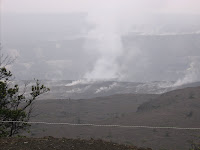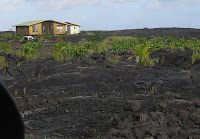We left the highlands where Captain Cook is located and started the trek around the north end of the island. As we drove up highway 19 along the coast we saw not only endless black lava fields but lots of what is called eco-friendly Hawaiian graffiti. On the black lava fields people have taken pieces of shell and coral from the coast and have written messages. Sometimes it is profound and other times it sinks to the level of graffiti else where in the world. The best thing about it is that all of it can be moved. It is an accepted part of the graffiti that anyone can “borrow” material from someone else to make a new message.
The topography of the island changes dramatically as we travel the coastal road. The lava fields are almost totally barren, their age defined by the amount of grasses and trees that have established a foothold in the black granulated soil scatted among the frozen lava flows. As we hit the north coast we find lush hills and tropical rain forests.
Since Waikiki was apparently devoid of anything but a consumer culture we looked eagerly for something that connects with the “old” Hawaii. We stop at a National Historic site called Pu'ukoholă Heiau which housed a revered site used by the Hawaiians for hundreds of years but noted primarily for a structure that King Kamehameha built just prior to solidifying his position as the first king of all the Hawaiian Islands.
The structure is a huge platform of stones (with no mortar used) that had to be moved (by hand) from 20 miles away. Since the stones couldn't (for religious reasons) touch the ground they formed a human chain, for an entire year, to transport them. The real quirky part is that this was supposed to be a temporary structure. The rest of the site was had been used by Hawaiian royalty for hundreds of years, including a temple structure out in the water, that had been used to offer sacrifices to the shark god.
The second stop was a state park (Lapakahi) that had been in use as a village site for over 600 years. The remains of building foundations were scattered around the grounds as were wells, landing sites and other remnants of their lives. The really weird thing was one of the exhibits was a stone about waist high that supposedly contained the spirit of a fishing god. The fishermen of the village u
 sed to make offerings to the stone to ensure that their catches were good. Knowing that it had a special heritage significance I removed a small stone from the top of the big stone. I don't know what it was but there was a “something” that shot through me and made me make a big step back. I told Lana about it and her advice was to touch it again. Afraid that I was tempting some kind of fate I refused. Never piss off the local deities has always been a rule I have tried to live by.
sed to make offerings to the stone to ensure that their catches were good. Knowing that it had a special heritage significance I removed a small stone from the top of the big stone. I don't know what it was but there was a “something” that shot through me and made me make a big step back. I told Lana about it and her advice was to touch it again. Afraid that I was tempting some kind of fate I refused. Never piss off the local deities has always been a rule I have tried to live by.After that we travelled up the coast to visit the Pololu Valley lookout. We came upon lots of ranches and horses and it didn't look at all like the island image that I had in my mind. The road then took us around the top of the island through a sparsely populated area and through areas that looked like the uplands of BC. For those of you from there it looked a lot like the land around Merritt. In the distance there is the bulk of the 13,700 ft Mauna Kea. On the very top you can just see the observatories that are there as well as the snow. Yes snow in Hawaii. From the picture in the local paper it seems that some hardy souls even get their snowboards out and slide down the slopes. No lift lines but then again there are no lifts either.
We stayed the next two nights in the hostel in downtown Hilo on the other side of the island from Kona. Downtown Hilo is not exactly the best looking place but the hostel itself is an old (1920s) second floor office area with 12 foot ceilings, lots of windows and creaky wooden floors. Other than being too quiet, (imagine living in a library) it was a pretty cool place. Apparently there are no bugs in Hilo since there were no screens over windows. The real highlight, and I mean that literally, was the street light that came shining through the window once it got dark.
The first day in Hilo we went up to the most active volcano in the world Mauna Loa – the legendary home of Pele – the Hawaiian goddess of fire. On that day however her fires were quenched and we had a taste of Hinakuluiau the Hawaiian god of rain. It rained steadily, at times
 in a real tropical downpour, as we made the 30 mile drive to the summit. There are lots of steam vents in the national park surrounding the crater at the top but many of the best lookout points were off limits because of some recent explosions. We did make the (very) roundabout trip to try to view where the latest lava flow is hitting the sea. For safety sakes they keep everyone a long way back and mostly all you see is a long plume of steam where the lava hits the ocean.
in a real tropical downpour, as we made the 30 mile drive to the summit. There are lots of steam vents in the national park surrounding the crater at the top but many of the best lookout points were off limits because of some recent explosions. We did make the (very) roundabout trip to try to view where the latest lava flow is hitting the sea. For safety sakes they keep everyone a long way back and mostly all you see is a long plume of steam where the lava hits the ocean.Just is case you are ever asked during the game of trivial pursuit which is the most massive mountain on earth it is Mauna Loa. When measured from its base on the ocean floor it is 27,000 feet higher than Mt. Everest. Or at least what they say in the park Visitor's Centre.
On the road there we had to drive over a fairly recent flow which already had people living on it. At least they don’t have to cut the grass.

I guess the old saying about not them not making any more land is true everywhere but the island of Hawaii.
No comments:
Post a Comment